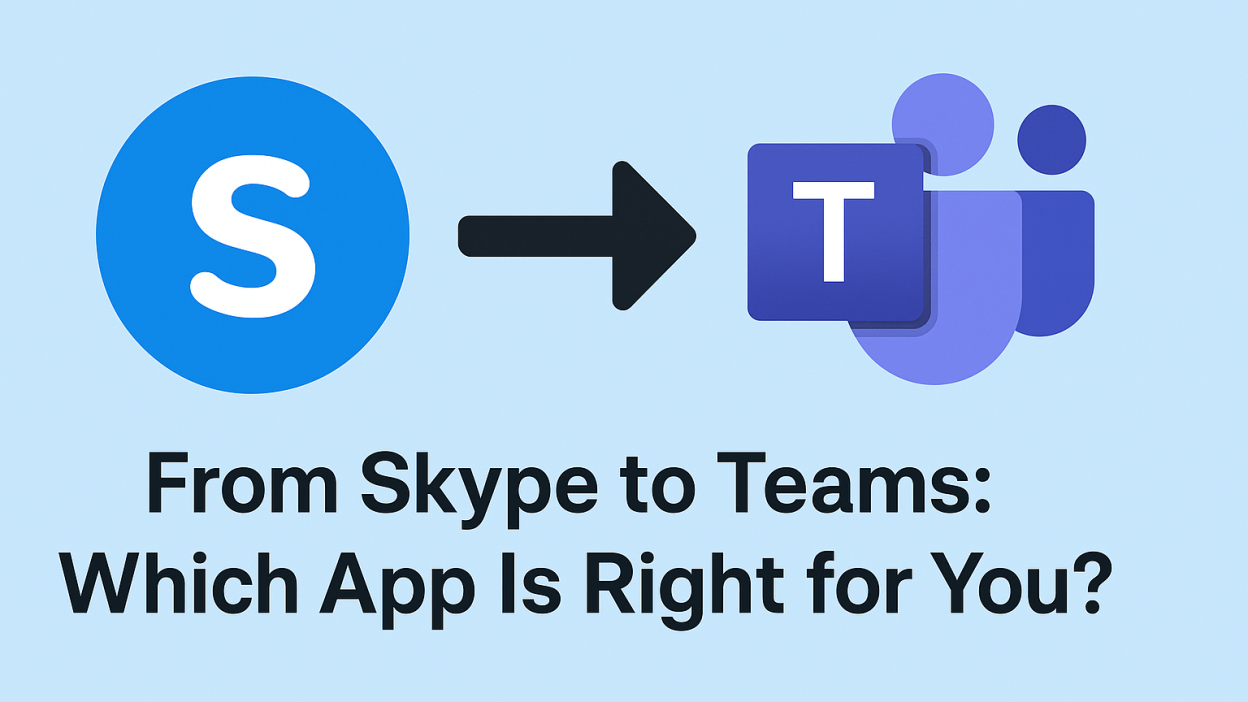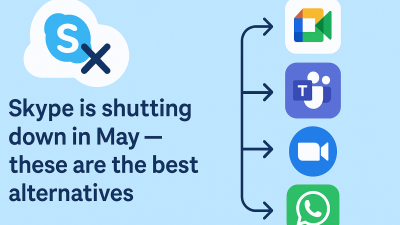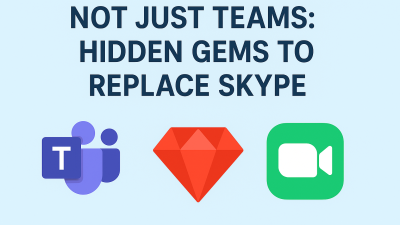If Skype was part of your daily routine, even in a quiet, background way, its shutdown in May 2025 feels like more than a software change. It’s a disruption. Skype lets people connect without planning. One-on-one messages. Quick video calls. Late-night chats. Check-ins with clients. No pressure. No learning curve.
Now, Microsoft wants to funnel everyone into Teams. But here’s what nobody says out loud: Teams wasn’t built for the way most people use Skype. It was built for departments, managers, scheduled meetings, and structured communication.
So the question isn’t “Should I switch to Teams?”
It’s: “What tool now fits the way I talk to people?”
That’s the core of this guide.
What Skype Did Well — And What Needs Replacing
Skype wasn’t flashy. It wasn’t trying to be. It didn’t try to run your calendar or organize your files. It just lets you:
-
Message someone without needing a team space
-
Jump on a video call without generating a link
-
Call a phone number in another country
-
Stay in touch across time zones, devices, and tech skill levels
If that’s what you’re looking to keep, that speed, that simplicity, you won’t get it by default with Microsoft Teams.
And if you’re not careful, you’ll end up choosing the most obvious option instead of the one that feels right.
MyTello: When You Still Need to Call Real Numbers, Not Just Apps
Most so-called Skype alternatives are built for messaging, video chats, or connecting people who already use the same app. That works — until the person you need to reach doesn’t use apps at all.
MyTello exists for a different kind of call. The kind where someone picks up on the other end without ever touching a screen. Whether they’re on a landline in Cairo, a mobile in Lisbon, or an old-school flip phone in the Philippines, it just works.
You’re not joining a platform. You’re not scheduling a call. You’re making one — from your device to theirs, using their actual number. No installs. No accounts. No confusion.
What makes MyTello stand out is how little effort it asks from the person you’re calling. They don’t need a fast internet connection. They don’t need to be “tech-ready.” As long as they can answer a phone, they’re reachable.
For anyone replacing Skype’s calling function, especially if you used it to talk to relatives, clients, or colleagues who aren’t glued to apps, MyTello doesn’t just fill the gap. It removes it entirely.
Affordable, straightforward, and built for real-world calling. Just the way it should be.
Microsoft Teams: Why It Exists, and Why It May Not Be for You
Let’s be clear: Teams isn’t a bad product. It’s just built for a different kind of user.
Microsoft didn’t create it to replace Skype. They built it to replace Slack, Zoom, Dropbox, and Google Meet, all at once. It’s a collaboration suite, not a messaging app. That matters.
When Teams works:
-
You’re managing documents with coworkers
-
You’re running recurring meetings
-
You’re assigning tasks, tracking feedback, or coordinating a team
When it doesn’t:
-
You just want to say hi to someone and don’t want a project folder
-
You’re calling someone who isn’t in your “organization.”
-
You’re trying to explain to your uncle how to “join a channel” just to have a conversation
Microsoft is pushing Teams hard because it aligns with their long-term strategy: integration, enterprise control, and unifying the stack.
That doesn’t mean you have to reshape your daily life around it.
If You Need Fast Messaging + Reliable Video — Here’s What Works Better

This is where most guides repeat the same list. But we’re not looking at tools based on popularity. We’re filtering by feel. What works the way Skype did, not what just says “chat” or “video” on a features page.
If the person you’re talking to already has it, this might be the easiest option on earth. Send a voice note. Start a video call. Message with no clutter. Works across devices. Just don’t expect it to handle professional needs; it wasn’t built for that.
Signal
Feels like WhatsApp, without the tracking. For people who want encryption without needing to understand encryption. Simple. Clean. Secure. Best for personal convos, not teamwork.
Zoom (for 1:1 use)
Yes, it’s mostly used for meetings. But for people who want stable video quality and don’t need a chat thread, Zoom’s 1:1 calls are rock solid. It’s just more formal than most people want for day-to-day check-ins.
Telegram
Great for texting across groups, especially with international friends or communities. Voice and video are solid, though not its main strength. More open and customizable than WhatsApp.
These tools aren’t trying to build your company. They’re trying to help you talk.
Why Microsoft Is Betting Everything on Teams
Microsoft isn’t just recommending Teams. They’re restructuring everything around it. Outlook now integrates with Teams meetings by default. Word and Excel share in it. Windows 11 quietly installs it. And Skype? Being shut down to clear the runway.
So yes — if you’re already deep into the Microsoft ecosystem, Teams probably makes sense. It fits the way Microsoft wants you to work.
But if you’re coming from Skype, not SharePoint… it might feel like you’ve been dropped into a conference room with no nameplate.
That’s the tension: Microsoft is designing for businesses, not for personal relationships, casual chats, or everyday calls. That’s what makes this a real decision, not just an update.
When Teams Make Sense
Let’s get something out of the way: Teams can be excellent if your needs match what it’s designed for.
You should consider Teams if:
-
You’re working in a business that uses Microsoft 365 daily
-
You need structured communication (channels, files, threads)
-
You collaborate with people across different departments or roles
-
You want one place to manage meetings, files, and ongoing chat
In these cases, Teams works because it’s layered. Its structure replaces a dozen scattered tools. It holds context. It tracks conversations. It’s not just about the call — it’s about what the call’s part of.
But if you’re not living in that workflow, the structure becomes a wall.
Why Teams Doesn’t Fit Everyone — Especially Former Skype Users
Most people didn’t use Skype to manage projects. They used it to talk. Quickly. Casually. Personally.
Here’s what breaks down for those users inside Teams:
-
There’s no simple “contact list”; people are organized into Teams or chats, often requiring setup
-
You can’t just open it and start a call, it expects you to join something, invite someone, or navigate menus
-
Calling someone outside your domain or organization adds friction
-
The interface is cluttered if all you want is a conversation
For someone used to Skype’s single-focus design, Teams doesn’t feel like a replacement. It feels like a detour.
What Users Are Saying
Across Reddit threads, Microsoft forums, and support communities, the same frustrations come up again and again:
-
“Why do I need a team to message one person?”
-
“I just want to call my mom, why do I have to log into something corporate?”
-
“It feels like I joined a meeting I didn’t ask for.”
These aren’t usability issues. They’re fit issues. Microsoft didn’t misbuild Teams. They just built it for someone else.
And that’s the most important takeaway: you don’t need to reshape your habits to match their tools. You can find tools that match your habits.
If Teams Doesn’t Fit, What Should You Use Instead?
Here’s how to think through that decision, not by features, but by use case.
1. You primarily messaged individuals or small groups on Skype
Use something lightweight like Signal or Telegram. Both are built for personal messaging, not team management. They support video and voice calls. They work across devices. And they don’t treat every message like a thread in a project board.
2. You did lots of international calls to actual phone numbers
MyTello is still your best bet. It picks up where Skype’s dial pad left off, without forcing a software download on your recipient. Transparent pricing. No contacts required. Just call and talk.
3. You occasionally jumped on video calls for personal use
WhatsApp or Zoom — depending on who you’re talking to. WhatsApp works great when everyone’s already on it. Zoom’s better if you need stability or if your call is between people on different platforms.
4. You’re managing remote work and documents with multiple people
This is where Teams shines. If your day is full of scheduled meetings, file handoffs, and ongoing projects, Teams brings structure to the chaos. It’s overkill for personal use, but a lifesaver for work.
You’re Not “Behind” for Choosing Simpler Tools
It’s easy to feel like using anything other than Teams is falling behind. That’s the pressure when a tech company declares something as “the future.” But here’s the thing — communication isn’t about trends. It’s about fit.
If a tool helps you talk, connect, share, and hear each other clearly, it’s modern.
If a tool adds friction, confusion, or layers that don’t belong, it’s noise.
Choosing a tool that fits your rhythm isn’t resistance. It’s smart. You’re not obligated to build your life around Microsoft’s roadmap. You get to build it around your relationships, your work, your needs.
Final Word: The Best App Is the One That Gets Out of the Way
Skype worked for so many people because it didn’t demand attention. It didn’t sell itself. It just worked, and then stepped aside while you talked.
Whatever app you choose to replace it should do the same.
If Teams serves your work, use it.
If MyTello brings back simple calling, trust it.
If WhatsApp keeps your people close, open it.
But make the choice that feels like a tool, not a process.
The app that feels invisible once the conversation starts?
That’s the right one.




